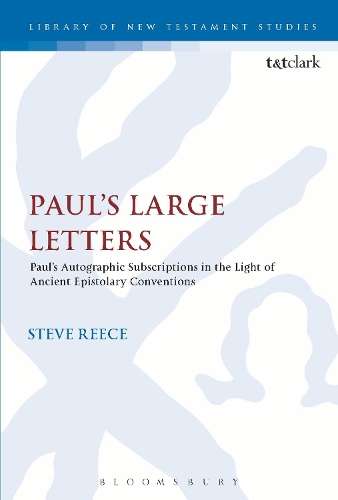
Paul's Large Letters: Paul's Autographic Subscription in the Light of Ancient Epistolary Conventions
(Hardback)
Available Formats
Publishing Details
Paul's Large Letters: Paul's Autographic Subscription in the Light of Ancient Epistolary Conventions
By (Author) Professor Steve Reece
Bloomsbury Publishing PLC
T.& T.Clark Ltd
15th December 2016
United Kingdom
Classifications
Tertiary Education
Non Fiction
Criticism and exegesis of sacred texts
New Testaments
227.06
Physical Properties
Hardback
256
Width 156mm, Height 234mm
635g
Description
At the end of several of his letters the apostle Paul claims to be penning a summary and farewell greeting in his own hand: 1 Corinthians, Galatians, Philemon, cf. Colossians, 2 Thessalonians. Pauls claims raise some interesting questions about his letter-writing practices. Did he write any complete letters himself, or did he always dictate to a scribe How much did his scribes contribute to the composition of his letters Did Paul make the effort to proofread and correct what he had dictated What was the purpose of Paul's autographic subscriptions What was Paul's purpose in calling attention to their autographic nature Why did Paul write in large letters in the subscription of his letter to the Galatians Why did he call attention to this peculiarity of his handwriting A good source of answers to these questions can be found among the primary documents that have survived from around the time of Paul, a large number of which have been discovered over the past two centuries and in fact continue to be discovered to this day. From around the time of Paul there are extant several dozen letters from the caves and refuges in the desert of eastern Judaea (in Hebrew, Aramaic, Nabataean, Greek, and Latin), several hundred from the remains of a Roman military camp in Vindolanda in northern England (in Latin), and several thousand from the sands of Middle and Upper Egypt (in Greek, Latin, and Egyptian Demotic). Reece has examined almost all these documents, many of them unpublished and rarely read, with special attention to their handwriting styles, in order to shed some light on these technical aspects of Paul's letter-writing conventions.
Reviews
R.s interpretation of Pauls large letters at the end of Galatians is based on solid ground, i.e. originally preserved papyrus letters, and definitely deserves to be regarded as the most serious study of the issue. * Biblica *
A major and definitive step forward Reece's specialties in palaeographical and comparative issues have here contributed greatly to Pauline and New Testament studies. It is a necessary read for Pauline scholars and even readers at the advanced undergraduate level will find it both accessible and beneficial. * Bryn Mawr Classical Review *
This book is an important work in Pauline studies and deserves the concern of more scholars. * Biblical Interpretation *
Author Bio
Steve Reece is Professor of Classical Languages and Boldt Distinguished Teaching Professor in the Humanities at Saint Olaf College in Northfield, Minnesota, U.S.A.
